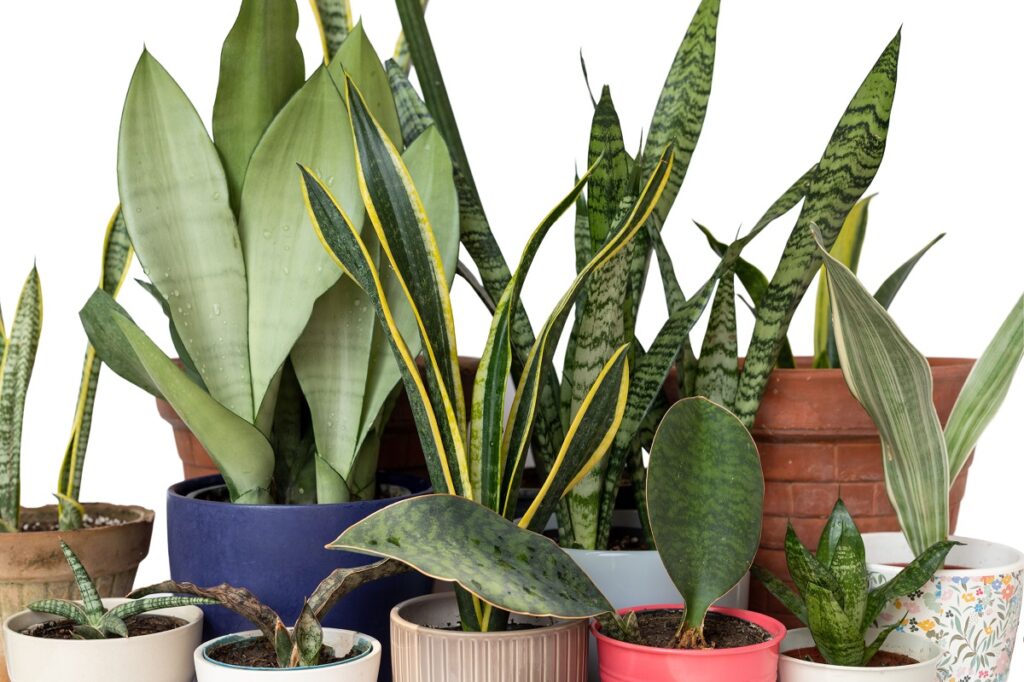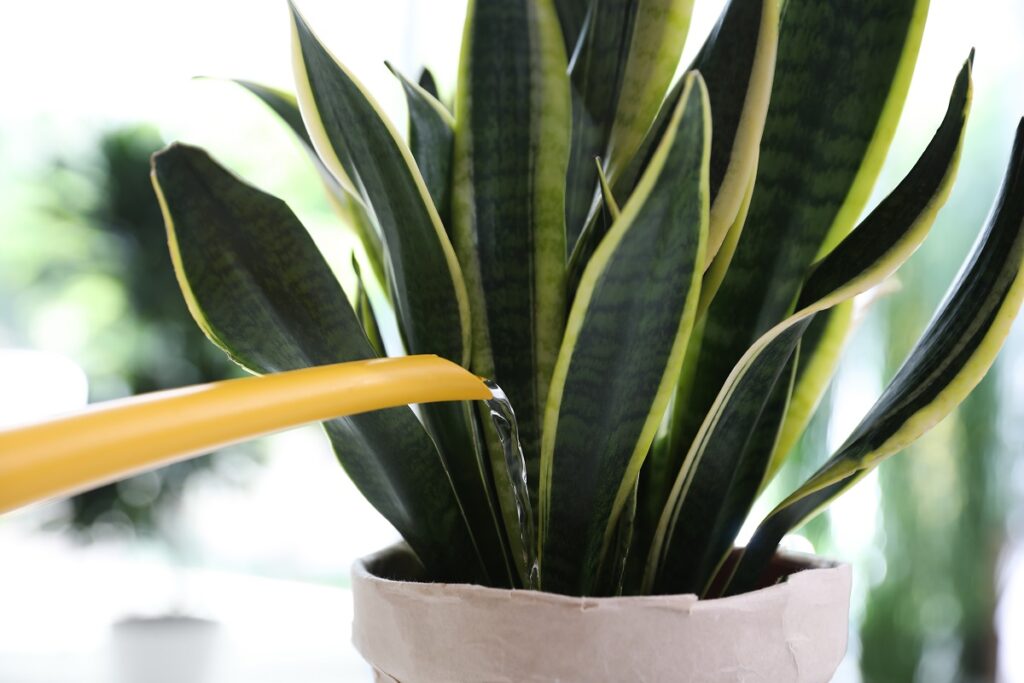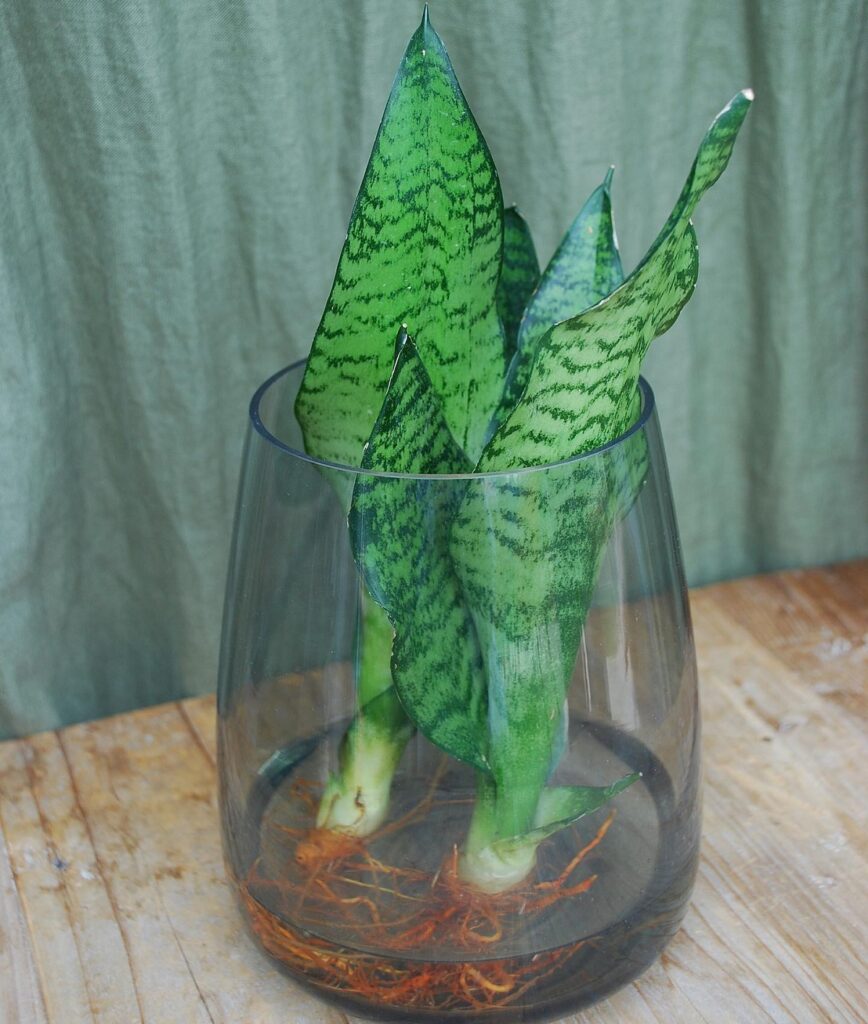Have you ever wondered if your snake plant needs fertilizer? It’s an important question to ask when it comes to keeping your beloved houseplant healthy and happy. After all, getting the right care for any type of plant is essential!
In this article, we’ll explain why fertilizing a snake plant may be necessary and what kind of fertilizer should be used in order to get the best results. You’ll learn about the signs that indicate when it’s time to fertilize, as well as some other tips to help keep your snake plant looking its best.
So whether you’re a newbie or an experienced green thumb, this article will provide all the information you need to make sure your snake plant gets the nutrients it needs. Let’s dive into understanding how and when to properly feed these beautiful plants!

Contents
- 1 Do Snake Plants Need Fertilizer?
- 2 What Is The Best Fertilizer For A Snake Plant?
- 3 How And When To Fertilize A Snake Plant
- 4 How To Fertilize Snake Plant Grown In Water
- 5 What Happens If You Over-Fertilize Your Snake Plant?
- 6 Frequently Asked Questions
- 6.1 What is the best organic fertilizer for snake plants?
- 6.2 How do you make a snake plant grow faster?
- 6.3 Does coffee help snake plants?
- 6.4 Are eggshells good for snake plants?
- 6.5 Does milk help snake plants?
- 6.6 How do I make my snake plant shine?
- 6.7 What nutrients do snake plants like?
- 6.8 How do I make my snake plant fuller?
- 7 Conclusion
Do Snake Plants Need Fertilizer?
Do snake plants need fertilizer? Yes, they do! Like all living things, even those that thrive in low-light environments like the snake plant, require nutrients to stay healthy. The best way to ensure your beloved houseplant gets what it needs is by using organic fertilizers and a balanced fertilizer specifically formulated for indoor plants.
But how often should you fertilize your snake plant? Snake plant care recommends feeding them every two weeks during their active growing period with either liquid or granulated organic fertilizer at half strength. You can also incorporate slow-release pellets if you prefer less frequent applications. Additionally, occasional additions of blood meal are beneficial because they provide extra nitrogen which helps with foliage growth.
It’s important to remember that too much of anything isn’t good—including fertilizer! Overfertilization can damage roots and cause nutrient deficiencies. To avoid this problem make sure you evenly distribute the fertilizer throughout the potting soil and water before application so there’s an even distribution of nutrients in the soil profile when it comes time for absorption.

What Is The Best Fertilizer For A Snake Plant?
The previous section discussed the need for fertilizer in snake plants. But what type of fertilizer is best to use?
When it comes to choosing a fertilizer for your snake plant, there are several options available. You can use liquid snake plant fertilizer or slow-release plant food. Liquid fertilizers should be applied every month during the growing season and diluted according to package instructions. Slow-release fertilizers are usually applied three times per year; once each in spring, summer and fall.
Generally speaking, synthetic fertilizers provide more nutrients than organic ones do. However, if you’re looking for an eco-friendly option, then organic fertilizers may be a better choice. It’s also important to make sure that whatever type of fertilizer you choose contains all the necessary macronutrients such as nitrogen, phosphorus and potassium.
Finally, when applying any type of fertilizer to your snake plant, make sure not to overdo it! Too much fertilizer can burn the leaves or roots of your beloved houseplant. As with anything else related to gardening and caring for plants, moderation is key when using any type of fertilizer on your snake plant!
How And When To Fertilize A Snake Plant
Snake plants don’t need a lot of fertilizer, but they do benefit from occasional fertilizing! If you want to give your snake plant an extra boost, it’s best to use one of the three types of fertilizer: liquid, granular or slow-release.
- Liquid fertilizers are applied directly to the soil and can be used every two weeks during active growth periods.
- Granular fertilizers should be sprinkled around the base of the plant and watered in thoroughly each month during the growing season.
- Slow-release fertilizers are ideal for those who find themselves too busy to remember regular applications—these pellets slowly release their nutrients over time instead of providing them all at once.

No matter what type of fertilizer you choose, make sure that it is specifically designed for snake plants—look for ones with high levels of nitrogen, phosphorus and potassium like water-soluble fertilizer or even organic options such as worm castings or fish emulsion. When applying any kind of fertilizer, be careful not to overdo it! Too much nutrient buildup can cause root burn or other damage so start off by using half the recommended amount on the product label and work up if needed.
When choosing when to apply these products, keep in mind that most snake plants grow actively from spring through early fall before entering dormancy over winter months. Fertilize lightly during this period and stop entirely after October then resume again in April when new growth starts appearing. With just a bit of tender loving care, your snake plant will stay healthy and vibrant year-round!
How To Fertilize Snake Plant Grown In Water
Now that we’ve discussed when and how to fertilize a snake plant, let’s look at how to fertilize a snake plant grown in water. Growing snake plants indoors can be challenging given their light requirements, but if you keep them watered they can thrive. As with any indoor plant, it’s important not to use too much fertilizer—excess fertilizer can burn the roots of your snake plant and stunt root growth.

When using fertilizer for an aquatic environment like this one, make sure you read the instructions on the label carefully. The amount of nutrients required will vary depending on the volume of water used for growing your snake plants. Many liquid fertilizers are specifically made for irrigated systems such as these so it pays to do some research beforehand.
Make sure to add only small amounts of fertilizer at first and monitor the reaction from your plants before adding more. It may take some experimentation to find the right balance between providing enough nutrition while avoiding overly-concentrated water conditions—both extremes can have negative impacts on your snake plants’ health! With proper care and attention, however, you should be able to successfully grow healthy snake plants in water without running into issues along the way.
What Happens If You Over-Fertilize Your Snake Plant?
When it comes to fertilizing your snake plant, it’s important to remember that too much of a good thing can actually be bad. Over-fertilization with synthetic fertilizers can lead to fertilizer burn, which means the plant will suffer from an accumulation of salts in its soil and roots. This could cause yellow leaves, leaf burn, or even death.
To avoid this risk there are a few steps you should take:
- Start by only fertilizing it every six months. Remember that snake plants don’t need a lot of fertilizer to stay healthy.
- When you do fertilize, use a balanced fertilizer that is low in nitrogen, like a 10-10-10 fertilizer. You should also dilute the fertilizer to half the strength recommended on the label.
- If you have over-fertilized your snake plant, flush out the soil with clean water. This will help to wash away any excess fertilizer that may have been left behind.
It’s also important to keep an eye on any new growth; if they start appearing discolored or deformed then stop using the fertilizer immediately and flush out the excess nutrients with water until they return back to normal. Taking these precautions will help ensure your snake plant stays healthy and happy!
Frequently Asked Questions
What is the best organic fertilizer for snake plants?
The best organic fertilizer for snake plants is a balanced, slow-release fertilizer. These fertilizers provide all the essential nutrients that snake plants need to thrive, while also releasing them slowly over time. Examples of such fertilizers include fish emulsion, kelp meal, and compost tea. Additionally, it’s important to remember to feed your snake plant at the correct rate, as too much fertilizer can burn the plant’s roots and cause damage.
How do you make a snake plant grow faster?
To make a snake plant grow faster, you should ensure that it is in bright, indirect light and that the soil is well-draining and allowed to dry between watering. Additionally, you should fertilize the plant every month or two during the growing season. To ensure the plant stays healthy, you should also check for pests and diseases regularly. If you notice any signs of distress, you should address the issue immediately.
For best results, you should also repot your snake plant every two to three years to prevent it from becoming root-bound. This will help to provide the plant with more space and nutrients to grow.
Does coffee help snake plants?
Coffee is not typically recommended as an addition to the soil of snake plants. Too much caffeine in the soil can cause the plant to become overly stimulated, leading to leaf burn and other issues. Snake plants are also sensitive to fertilizers and other nutrients, and adding coffee could upset the delicate balance in the soil. Furthermore, the acidity level of coffee can be too high for the plant, leading to root burn and other damage. For these reasons, it is best to avoid using coffee for snake plants.
However, it is important to note that snake plants prefer well-draining, slightly acidic soil. If the soil is too alkaline, the plant may struggle to thrive. Improving the soil’s drainage and acidity levels can be beneficial for the health of the plant. In this case, you can add a little coffee to the soil. Additionally, it is important to provide adequate water and light to ensure your snake plant remains healthy and happy.
Are eggshells good for snake plants?
No, eggshells are not good for snake plants. Eggshells contain calcium carbonate, which can raise the pH of the soil to a much higher level than the snake plant prefers. Too much calcium carbonate in the soil can also be toxic to snake plants, causing them to become stunted and discolored. If you want to add nutrients to your snake plant’s soil, it is better to use a balanced fertilizer or compost. Compost will also help retain moisture in the soil, which snake plants need to thrive.
Does milk help snake plants?
No, milk does not help snake plants. Snake plants prefer soil that is allowed to dry out between waterings, and milk contains high amounts of fat and protein that can actually cause root rot when added to soil. Snake plants also prefer soil with a slightly acidic pH, so adding milk to the soil can disrupt the soil’s natural pH balance. Additionally, milk can also attract pests to the plant.
How do I make my snake plant shine?

To make your snake plant shine, you can follow these steps:
- Dust the leaves: Use a soft, damp cloth or a feather duster to gently remove any dust or debris from the leaves of the plant. This will make them look cleaner and brighter.
- Apply neem oil: Mix a few drops of neem oil with water and apply it to the leaves of your snake plant using a soft cloth. This will help to remove any residual dirt or grime and also give the leaves a natural shine.
- Use a plant shine spray: There are several plant shine sprays available in the market that are specifically designed to give a shiny appearance to houseplants. You can choose one of these sprays and apply it to the leaves of your snake plant.
- Water your plant properly: Make sure your snake plant is getting enough water and is not being overwatered or underwatered. Proper watering will ensure that your plant remains healthy and its leaves look shiny.
- Provide adequate light: Snake plants prefer bright, indirect light, so make sure your plant is getting enough light. If the plant is not getting enough light, it may become dull and lose its shine.
By following these steps, you can help your snake plant to look its best and have a healthy, shiny appearance.
What nutrients do snake plants like?
Snake plants are known to be low-maintenance and can thrive in a variety of conditions, including nutrient-poor soils. However, adding some nutrients can help improve the growth and health of the plant. Here are some nutrients that snake plants like:
- Nitrogen: Nitrogen is an essential nutrient for plant growth, and snake plants can benefit from nitrogen-rich fertilizers. Nitrogen helps to promote healthy foliage growth and encourages the production of chlorophyll, which is responsible for the plant’s green color.
- Phosphorus: Phosphorus is another important nutrient for plant growth, and it helps to promote root development, flowering, and fruit production. Adding a phosphorus-rich fertilizer can be beneficial for snake plants.
- Potassium: Potassium helps to regulate water balance in plants and is essential for overall plant health. It also helps to improve the plant’s resistance to stress, pests, and diseases. Adding a potassium-rich fertilizer can be helpful for snake plants.
- Calcium: Calcium is important for the structural integrity of cell walls in plants. It also helps to prevent leaf tip burn and other calcium deficiency-related problems. Adding a calcium supplement to the soil can be beneficial for snake plants.
It’s important to note that snake plants are sensitive to over-fertilization, so it’s best to fertilize them sparingly. A general-purpose fertilizer with an NPK ratio of 10-10-10 can be used every 2-3 months during the growing season to provide adequate nutrition to your snake plant.
How do I make my snake plant fuller?
To make your snake plant fuller, you can follow these steps:
- Repot your plant: If your snake plant has outgrown its current pot, it may be time to repot it into a larger container. This will give the roots more space to grow, and the plant will be able to absorb more nutrients and water, which can promote fuller growth.
- Divide the plant: If your snake plant is large and has multiple stems, you can divide it into smaller plants. This will allow each plant to have more space to grow and develop a fuller appearance.
- Provide adequate light: Snake plants prefer bright, indirect light, so make sure your plant is getting enough light. If the plant is not getting enough light, it may become leggy and sparse.
- Water your plant properly: Overwatering or underwatering can cause the leaves of the snake plant to become thin and sparse. Make sure you are watering your plant properly, allowing the soil to dry out slightly between waterings.
- Fertilize your plant: Adding some fertilizer to your snake plant can help promote fuller growth. A general-purpose fertilizer with an NPK ratio of 10-10-10 can be used every 2-3 months during the growing season.
- Prune your plant: Pruning your snake plant can help encourage fuller growth by removing any dead or damaged leaves and promoting new growth. Use a sharp, clean pair of scissors or pruning shears to remove any unwanted leaves.
By following these steps, you can help your snake plant to develop a fuller appearance and thrive in your home.
Conclusion
In conclusion, it is important to understand if snake plants need fertilizer and how best to fertilize them. Snake plants can survive without any additional nutrition but regular feeding will help your plant reach its full potential. With the right kind of fertilizer, you can keep your snake plant healthy for years to come.
When deciding if a snake plant needs fertilizer and when to apply it, always be sure to research what type of fertilizer works best for your particular species as not all fertilizers are created equal. Additionally, make sure not to over-fertilize your snake plant as this could lead to nutrient burn or other issues that may affect the health of your beloved houseplant.
Ultimately, caring for a snake plant with proper watering and occasional light applications of fertilizer will ensure they grow strong and remain healthy in their homes indoors—giving both you and your new companion plenty of enjoyment!
